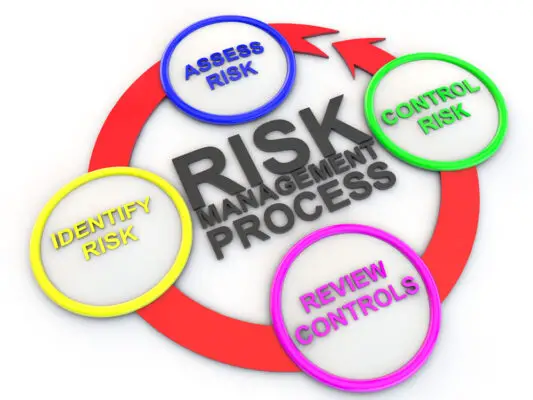Risk transfer is the technique that shifts the financial consequences of an event from one party to another. The goal is to protect the party responsible for transferring the risk from any potential losses due to an event. There are various ways to transfer risk, but insurance is one of the most common.
By purchasing insurance, you effectively transfer the risk of certain events (e.g. fire, theft, accidents) to the insurance company. In exchange for this protection, you agree to pay a premium. An insurance policy will be offered for protection, and an insurance premium will be selected. Periodic payments for premiums are crucial for insurance companies to offer compensation.
If an event covered under the insurance policy occurs, the insurance company will pay for any damage or losses up to the policy’s limit. Other methods of risk transfer include hedging, collateralization, and self-insurance. Each has its own advantages and disadvantages, but all can be effective ways to protect against potential losses.
If your company makes a mistake, it is essential to take the right measures to avoid incurring any financial risk. A contract that explains the responsible parties’ roles before the start of the project may save you money as a result of court action.
Contractual risk transfer provides a legally binding method of risk transfer to the person with the greatest potential for controlling the risks associated with a particular service.
Risk transfers involve transferring the risk of injury or damage to a financial asset, arising from a firm you hired – a supplier or contractor. Commercial properties assuming the risk of maintaining bare sidewalks is an example of transfer risk. Reinsurance companies also partake in this business through an insurance agent.
Risk transfer has become an increasingly important part of the risk management as businesses have learned that avoiding risk is not always possible. By transferring such risks to another party, business owners can mitigate their exposure and protect themselves from financial losses.
There are various ways to transfer risk, and each type has its benefits and drawbacks. In this blog post, we will explore the different types of risk transfer and discuss how each is used in business. We will also look at real-world examples to illustrate how this process works.

Introduction to Risk Transfer
Risk transfer is the term the industry uses as the definition of risk management, where risk is transferred from one person to another. Essentially, it entails passing on the risk of any future incident to someone else, which can happen at any time without delay.
Risk transfer agreement
Risk transfer agreements are agreements between two parties describing the terms and conditions of the contract and must be binding between the parties. These arrangements are written, not verbal, and describe the terms and conditions that cover the loss and the extent it will bear.
It provides information on a policy owner’s periodic payment, referred to as the premium, the coverage, and the circumstances under which the policyholder may claim financial compensation.
Real-life examples of risk transfer
Practical scenarios can easily be identified with motor car insurance. Peter is claiming a motorcycle insurance policy for $1,000. This insurance company covers any damages to your vehicle and roadside assistance and expires on 31 December 2021.
Let us imagine his motor vehicle was damaged, and Peter paid $500 to fix his car. In such cases, a motorist can seek up to $1,000 in compensation from their insurance company since they pay their total vehicle insurance premium.
How does it work?
Now, we will explain the way the risk transfer theory works. Risk transfers typically occur with insurance. All insurance forms may serve to illustrate risk transfers.
An insurer’s agreement or arrangement is made between individuals, corporations, insurers, and insurance companies.
Explanation
A risk management system shifts the responsibility for the risk of incurring a potentially negative outcome. Risk transfer involves the contractual arrangement between two parties, in which one party pays a premium to a third party to reduce the loss associated with a damaged product for which risk management is carried out.

Reasons for transferring risk
It is important that risk is transferred to a second party in order to mitigate any future losses. There may be an unforeseen incident in the future that does not happen, and if so, the premium for the mitigation of the risk may expire.
Disadvantages of Risk Transfer
However, risk transfers have some disadvantages. Generally, the disadvantages are as listed below:
Any risk management strategy involves some amount of risk transfer. This is the process of shifting the responsibility and potential consequences of risk from one party to another. While risk transfer can be an effective way to reduce your liability exposure, it also has several disadvantages that should be considered before making any decisions.
One of the biggest disadvantages of risk transfer is that it can create moral hazards. This occurs when the party transferring the risk begins to act carelessly or recklessly, safe in the knowledge that they will not have to bear the consequences.
This can lead to an increase in accidents and injuries, ultimately costing the organization more money in higher premiums and deductibles than if they had simply kept the risks.
Another disadvantage of risk transfer is that it can be difficult to find a party willing to take on the risks involved. This is especially true for large or complex risks, such as those associated with natural disasters or major construction projects. In addition, even if a willing party is found, it may charge a premium for assuming the risks, which can eat into any potential savings.
Why transfer risk?
Transfers of risks eliminate the liability for the organization, placing that liability back in the hands of the insurer or the person signing the contract. Despite the existence of a legal or contractual obligation, the injury or loss caused by another party may cause an unavoidable lawsuit situation.
Effectively, a risk transfer allocates risk equitabilities and assumes responsibility for all risks in order to protect those parties’ interests. A second obvious reason to transfer risk is to protect an enterprise against financial risks.
A company purchases insurance to cover the costs associated with a certain unexpected event, such as a data breach, so the risks are transferable to the insurer. Other examples of indemnification clauses include contractual obligations to provide coverage to other parties, or reinsurance.
Other industries
Risk transfers are commonly encountered in industries such as the construction industry. In reality, risk transfer is incorporated as part of any signed contract. As a service reward, construction firms accept undertaking some risk associated with their construction projects. Property owners transfer risks quite frequently.
Commercial landlords face multiple problems when managing a tenant’s properties. In this context, property owners should implement an indemnity clause and hold harmless agreements, which relieve the indemnitor against any liability incurred by the indemnitee.
Indemnification clauses in contracts
In addition to the transfer of risk, the agreement typically includes an indemnification clause that guarantees that any possible loss is compensated. Also called hold-harmless clauses or save-harmless clauses, a claim is unrelated to insurance coverage and cannot be enforceable against any other entity.
Risk Transfer in Risk Management
Risk management is a technique to prevent unplanned or unexpected situations from happening. You can reduce risk and additional costs when determining a potential threat to your company’s capital and earnings.
Typically, risk transfer occurs during the risk management phase of a risk management/mitigation program.
Conclusion
In business, the risk is an unavoidable part of the equation. When it comes to risk, there are three types: pure, speculative, and diversifiable. Each type has its own benefits and drawbacks, so businesses should carefully consider which type of risk they want to transfer and how best to do it.

Chris Ekai is a Risk Management expert with over 10 years of experience in the field. He has a Master’s(MSc) degree in Risk Management from University of Portsmouth and is a CPA and Finance professional. He currently works as a Content Manager at Risk Publishing, writing about Enterprise Risk Management, Business Continuity Management and Project Management.

